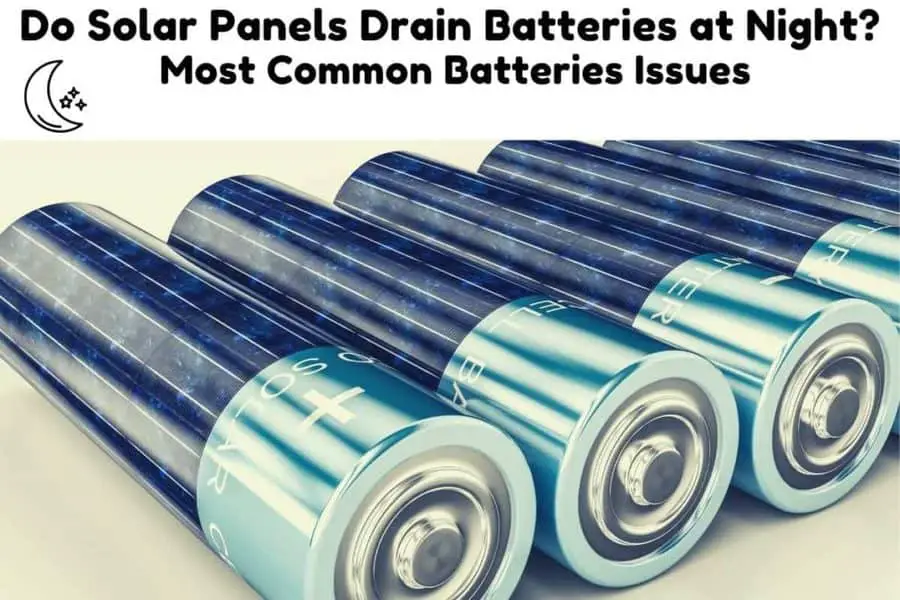Solar panels are a key component in a solar energy system. They absorb the sun’s energy and through the photovoltaic effect, convert the sunlight into the electricity that you use to charge your laptop and power your appliances.
Batteries are also a key component in a solar energy system. They are indispensable in an off-grid system as they store the energy a home will need after the sun sets and the solar panels stop producing energy.
They are also important in a grid-tied system as they help you reduce your use of utility-supplied energy. In that way, batteries can help you further reduce your energy bill.
So Does Solar Battery Discharge Overnight?
All batteries, regardless of whether they are connected to equipment or not, self-discharge. The rate at which the battery discharges will depend on whether it is connected to an appliance or not. An unconnected battery will discharge at a slower rate than a connected battery.
On a side note! If you’re in need of a reliable and high-performance portable solar panel, We strongly recommend the Jackery SolarSaga 100W Portable Solar Panel (Amazon Link).
With a high conversion efficiency and foldable design, this solar panel is easy to transport and set up, making it perfect for outdoor activities like camping, hiking, and RV trips.

The US solar cell technology used in this panel ensures that you get the most efficient and reliable solar charging possible.
There is also a 60W option that is more affordable (Amazon Link)
How do batteries and solar panels work together as part of a solar energy system? In this article, we will troubleshoot a few of the most common malfunctions relating to batteries in a solar system.

What Is Battery Discharge?
Batteries store energy or an electric current. Battery discharge is simply the electric current leaving the battery. When you use the energy in a battery you are discharging its electric current. The more energy that is used by the load on the battery, the greater the discharge.
The load on the battery is anything that is drawing energy from the battery. Loads can be small like lights, chargers, and shaving machines or they can be heavy like refrigerators, washing machines, and power tools.
Battery self-discharge
Batteries also discharge even when they are not connected to anything. This is called self-discharge and happens to every battery. The rate of self-discharge is mainly influenced by the type of battery, temperature, and age, with certain types of batteries having a higher rate than others. (Source)
| TYPE OF BATTERY | RATE OF SELF DISCHARGE PER MONTH |
| Lithium | 2% |
| AGM | 5% |
| Gel | 5% |
| Flooded Lead Acid | 5% |
Discharge through use and self-discharge account for the regular discharge of a battery. But what happens when the battery discharges and you do not know where or how the energy is going? For example, overnight when it is not in use. What could drain a battery in that way?
What Happens at Night with Solar Panels?
Solar panels can drain batteries at night. The electrical flow is reversed so instead of having energy go from solar panels to batteries, it goes from batteries to the solar panels. This is because there is no energy being produced by solar panels.
What is reverse flow?
Electricity does not flow in one direction. It has a two-way flow, moving from high potential to low potential. Just like water, electricity follows the path of least resistance.
When the sun is shining solar panels have more energy and batteries have less so the energy flows from the panels to the battery. When the sun goes down, the solar panels stop producing electricity and now it is the batteries that have more energy. The energy flow is reversed with energy flowing from the batteries to the solar panels.
The reverse flow also happens between solar panels. If your system has solar panels on different parts of your roof and some stop receiving sunlight before others, those panels will draw energy from the panels that are still getting sunlight.
Also, find out “If Solar Panels Work at Night with Moonlight?“
How to Stop Your Solar Panels from Draining Your Batteries ?
There are two ways to stop your solar panel from draining your batteries. You can either use a blocking diode or a solar charge controller to stop the reverse flow of energy from the batteries to the solar panels.
Using a blocking diode
Blocking diodes prevent back-feeding from your batteries to your solar panels. Blocking diodes can be installed anywhere along the line between your solar panels and batteries. Bypass diodes on the other hand prevent reverse flow between solar panels. (Source)
Using a charge controller
Charge controllers regulate the flow of energy to your battery from your solar panel. They are there to prevent your solar panels from overcharging your solar batteries. As soon as the batteries are full, the charge controller stops the flow of electric current going through. (Source)
Charge controllers also prevent current from leaving your batteries and going to your solar panels. In that way, charge controllers perform the basic function of regulating inflow and outflow in a battery.
Can you use blocking diodes and a charge controller?
Some solar panels already have diodes in them. But you do not need both a charge controller and diodes. If you already have diodes there is no need for a charge controller. If you have a charge controller there is no need for diodes unless you want to bypass diodes to prevent flow between solar panels.
What Happens to Solar Power when Batteries Are Full?
When batteries get full, they stop charging. The charge controller cuts off current flow to prevent overcharging which can damage the batteries. What happens to the energy generated after the batteries are full depends on the solar system configuration.
In an off-grid setup, the energy is sent to loads connected to the system through the inverter. In a grid-tied setup excess electricity not being used by any loads connected to the system is sent to the grid.
What to do with excess energy
Typically, most systems are small and there isn’t much energy left over after the battery is charged and the rest is diverted to use. Where there is excess energy, that energy can be sold to the grid or put to use. Rather than let it go to waste there are a few things that can be done with the excess energy.
The extra energy that remains after the battery is charged and the inverter load requirement is met is called the opportunity load. You can control what happens to the opportunity load with a charge controller.
You can use the excess for heating, cooling, or even running heavy loads like washing machines, dryers, and power tools.
For more on your solar panel settings, check out our post ” Can Solar Panels Work without A Battery? All You Need To Know!“
Do Solar Inverters Drain Batteries?
If the inverter is connected to a battery, it can drain the battery. This can happen even if there are no loads on the inverter.
The main factors that determine whether the inverter will drain the battery are:
- The efficiency of the inverter. More efficient inverters draw less energy from the battery.
- The size of the inverter in watts. The bigger the inverter the more power it will draw.
Depending on these factors, an inverter will draw anywhere between 0.2 to 2 amps per hour from your batteries.
Also, find out if Solar Power Lights Work in Winter?

